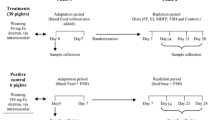Abstract
Effects of coprophagy and coprophagy preventing device on iron bioavailability were evaluated in two experiments. In Experiment 1, rats were fed diets with FeSO4, spinach, bran cereal or cornmeal as the iron source. The rats in each diet group were fitted with collars, sham-collars or not fitted with collars (control). In Experiment 2, rats were fed diets with FeSo4 or green peas as the iron source and were fitted with collars, tail cups, sham-collars or not fitted with any device (control). Preventing coprophagy reduced hemoglobin regeneration efficiency (HRE) of rats fed bran cereal, green peas, spinach or cornmeal diets by 26 (P<.05), 24(P<.05), 22(P<.05) and 11% (not significant), respectively. Preventing coprophagy in rats fed FeSO4 diet did not significantly reduce HRE. Sham-collaring reduced (P<.05) HRE of rats fed the FeSO4 diet by 12 and 13% but did not significantly affect HRE in rats fed food iron sources. It was more convenient and effective to prevent coprophagy with collars than with tail cups. Differences in bioavailability between food and FeSO4 iron due to coprophagy may be explained based on two gastrointestinal nonheme iron pools, complexed and highly soluble.
Similar content being viewed by others
References
Neale RJ (1982) Coprophagy in iron-deficient rats. Lab Anim 16: 204–207
Geever EF, Kan D, Levenson SM (1969) Effect of coprophagy on experimental iron absorption in the rat. J Nutr 98: 95–98
Agricultural Research Service, United States Department of Agriculture (1963) Composition of Foods. Agriculture Handbook No. 8. Washington, DC: US Government Printing Office, pp 6–67
National Academy of Sciences (1978) Nutrient Requirements of Laboratory Animals. 3rd Ed. Washington, DC: Printing & Publishing Office, pp 7–37
Timm K (1979) Orbital venous anatomy of the rat. Lab Anim Sci 29:636–638
Neale RJ (1984) Coprophagy in iron-deficient rats: II. 2 novel methods of prevention. Lab Anim 18: 119–124
Barnes RH, Fiala G, McGehee B, Brown A (1957) Prevention of coprophagy in the rat. J Nutr 63: 489–498
Zhang D, Hendricks DG, Mahoney AW, Cornforth DP (1985) Bioavailability of iron in green peas, spinach, bran cereal, and cornmeal fed to anemic rats. J Food Sci 50: 426–428
Zhang D, Hendricks DG, Mahoney AW (1989) Bioavailability of total iron from meat, spinach (Spinacea oleracea L.) and meat/spinach mixtures by anaemic rats. Br J Nutr 61: 331–343
Crosby WH, Munn SI, Furth FW (1954) Standardized method for clinical hemoglobinometry. US Armed Forces Med J 5: 693–703
Dowdy S, Wearden S (1983) Statistics for Research. New York: John Wiley & Sons, Inc
Ranger CR, Neale RJ (1984) Iron availability from soy, meat and soy/meat samples in anemic rats with and without prevention of coprophagy. J Food Sci 49: 585–589
Geisser P, Müller A (1987) Pharmacokinetics of iron salts and ferric hydroxide carbohydrate complexes. Arzneim.-Forsch./Drug Research 37: 100–104
Kalpalathika MPV, Mahoney AW, Whittaker P, Hendricks DG (1991) Incorporation of absorbed iron from different dietary sources into hemoglobin. Nutr Res (In press)
Author information
Authors and Affiliations
Rights and permissions
About this article
Cite this article
Zhang, D., Hendricks, D.G. & Mahoney, A.W. Effect of coprophagy on bioavailability of iron from plant foods fed to anemic rats. Plant Food Hum Nutr 42, 97–108 (1992). https://doi.org/10.1007/BF02196462
Received:
Accepted:
Issue Date:
DOI: https://doi.org/10.1007/BF02196462




